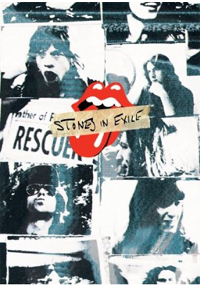Like the record it profiles, Stones In Exile is a montage, a fragmented collection of reflections and thoughts on what is arguably the greatest musical statement the Rolling Stones ever laid down on tape. In its unfocused framing, the record was mostly created during a hazy, drug-filled six months in the south of the France. Told primarily by the inner circle of the Exile era — Mick Jagger, Keith Richards, Charlie Watts, Bill Wyman, Mick Taylor, Anita Pallenberg, Bobby Keys, the dearly departed producer Jimmy Miller, photographer Dominique Tarle, and engineer Andy Johns — the film digs up the dirt on the whole sordid affair.
In an attempt to come off as contemporary and with it, testimonials from Benicio Torro, Caleb from Kings Of Leon and Will.I.Am book-end the piece. Hearing about Exile On Main Street from a Black-Eyed Pea probably won’t resonate with older fans, but, as it is obviously intended, it will more than likely intrigue the youngsters. Thankfully, Don Was, Martin Scorsese, and perhaps even Sheryl Crowe and Jack White, make a little more sense. Either way, the Stones’ follies during the making of Exile comprise all the elements of great rock and roll — this has a cross-generational appeal that defies the relic status. It’s a story everyone wants to know.
From the Stones’ tax problem to the ravaged mess in the basement of Richards’ chateau onto Los Angeles where the album wrapped, and then reception and impact— they’ve done a tidy job of sticking to the main talking points. Lots of the footage is taken from Cocksucker Blues, the unreleased Robert Frank film that documented the underside of the Stones’ 1972 tour. Hotel jam sessions and whiskey bottles and smoking guns. Then there’s Jagger hanging out on the roadside, in a deep Southern turn-off, singing the blues, the kind of blues that seeds and adorns the heart of Exile On Main Street.
The film goes to great lengths to unveil the debauchery in France. A little more of a bird’s eye view of the songs instead of the mayhem would have broadened the story, but this is part of the Stones’ charm. Tons of pictures, many, if not most, taken by Tarle. There’s shots of quite a few of the regulars who became part of Richards’ entourage, including Gram Parsons, who never is mentioned, despite his obvious influence on the band’s country leanings. For the most part, everyone seemed to look back at the sessions, despite their lack of productivity, with great fondness. “It’s rock and roll, son,” Keys enthuses.
The extra footage of Jagger and Watts wandering the house in Stargroves, where the Stones also recorded, and Olympic Studios in London, is a whole other side you rarely get to see. The bonus testimonials are bit self-indulgent, adding little to the overall presentation. In the end, Stones In Exile made me want to spin the remaster again. For my money, the music does all the talking I need to hear. Maybe, the DVD needed to explore the songs a little more deeply rather than dwelling on sensationalistic rehash. But that’s what it’s like with the Rolling Stones. Sha-doobie.
~ Shawn Perry




















